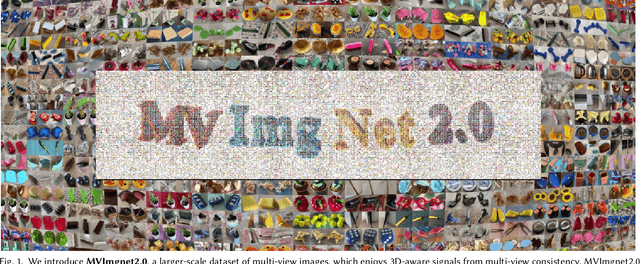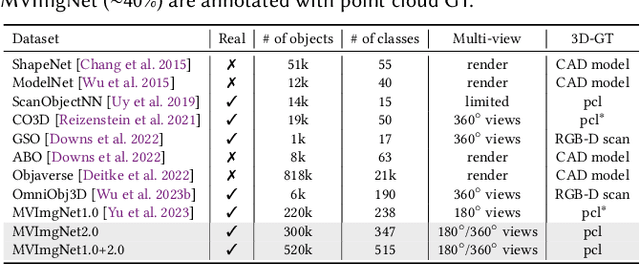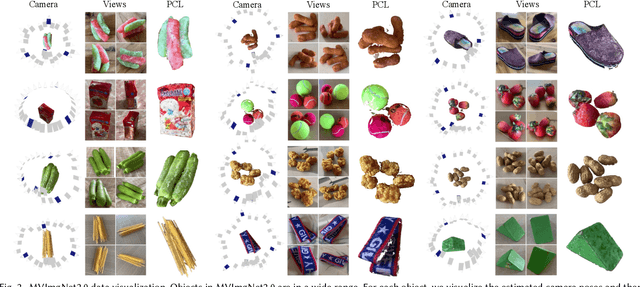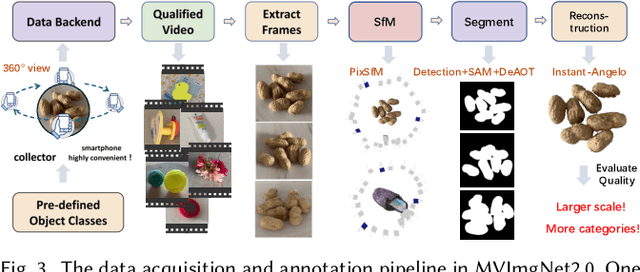Haolin Liu
refer to the report for detailed contributions
Hunyuan3D 2.1: From Images to High-Fidelity 3D Assets with Production-Ready PBR Material
Jun 18, 2025Abstract:3D AI-generated content (AIGC) is a passionate field that has significantly accelerated the creation of 3D models in gaming, film, and design. Despite the development of several groundbreaking models that have revolutionized 3D generation, the field remains largely accessible only to researchers, developers, and designers due to the complexities involved in collecting, processing, and training 3D models. To address these challenges, we introduce Hunyuan3D 2.1 as a case study in this tutorial. This tutorial offers a comprehensive, step-by-step guide on processing 3D data, training a 3D generative model, and evaluating its performance using Hunyuan3D 2.1, an advanced system for producing high-resolution, textured 3D assets. The system comprises two core components: the Hunyuan3D-DiT for shape generation and the Hunyuan3D-Paint for texture synthesis. We will explore the entire workflow, including data preparation, model architecture, training strategies, evaluation metrics, and deployment. By the conclusion of this tutorial, you will have the knowledge to finetune or develop a robust 3D generative model suitable for applications in gaming, virtual reality, and industrial design.
Adaptive Fault-tolerant Control of Underwater Vehicles with Thruster Failures
Apr 22, 2025Abstract:This paper presents a fault-tolerant control for the trajectory tracking of autonomous underwater vehicles (AUVs) against thruster failures. We formulate faults in AUV thrusters as discrete switching events during a UAV mission, and develop a soft-switching approach in facilitating shift of control strategies across fault scenarios. We mathematically define AUV thruster fault scenarios, and develop the fault-tolerant control that captures the fault scenario via Bayesian approach. Particularly, when the AUV fault type switches from one to another, the developed control captures the fault states and maintains the control by a linear quadratic tracking controller. With the captured fault states by Bayesian approach, we derive the control law by aggregating the control outputs for individual fault scenarios weighted by their Bayesian posterior probability. The developed fault-tolerant control works in an adaptive way and guarantees soft-switching across fault scenarios, and requires no complicated fault detection dedicated to different type of faults. The entailed soft-switching ensures stable AUV trajectory tracking when fault type shifts, which otherwise leads to reduced control under hard-switching control strategies. We conduct numerical simulations with diverse AUV thruster fault settings. The results demonstrate that the proposed control can provide smooth transition across thruster failures, and effectively sustain AUV trajectory tracking control in case of thruster failures and failure shifts.
Stable-SCore: A Stable Registration-based Framework for 3D Shape Correspondence
Mar 27, 2025Abstract:Establishing character shape correspondence is a critical and fundamental task in computer vision and graphics, with diverse applications including re-topology, attribute transfer, and shape interpolation. Current dominant functional map methods, while effective in controlled scenarios, struggle in real situations with more complex challenges such as non-isometric shape discrepancies. In response, we revisit registration-for-correspondence methods and tap their potential for more stable shape correspondence estimation. To overcome their common issues including unstable deformations and the necessity for careful pre-alignment or high-quality initial 3D correspondences, we introduce Stable-SCore: A Stable Registration-based Framework for 3D Shape Correspondence. We first re-purpose a foundation model for 2D character correspondence that ensures reliable and stable 2D mappings. Crucially, we propose a novel Semantic Flow Guided Registration approach that leverages 2D correspondence to guide mesh deformations. Our framework significantly surpasses existing methods in challenging scenarios, and brings possibilities for a wide array of real applications, as demonstrated in our results.
Unleashing Vecset Diffusion Model for Fast Shape Generation
Mar 20, 2025Abstract:3D shape generation has greatly flourished through the development of so-called "native" 3D diffusion, particularly through the Vecset Diffusion Model (VDM). While recent advancements have shown promising results in generating high-resolution 3D shapes, VDM still struggles with high-speed generation. Challenges exist because of difficulties not only in accelerating diffusion sampling but also VAE decoding in VDM, areas under-explored in previous works. To address these challenges, we present FlashVDM, a systematic framework for accelerating both VAE and DiT in VDM. For DiT, FlashVDM enables flexible diffusion sampling with as few as 5 inference steps and comparable quality, which is made possible by stabilizing consistency distillation with our newly introduced Progressive Flow Distillation. For VAE, we introduce a lightning vecset decoder equipped with Adaptive KV Selection, Hierarchical Volume Decoding, and Efficient Network Design. By exploiting the locality of the vecset and the sparsity of shape surface in the volume, our decoder drastically lowers FLOPs, minimizing the overall decoding overhead. We apply FlashVDM to Hunyuan3D-2 to obtain Hunyuan3D-2 Turbo. Through systematic evaluation, we show that our model significantly outperforms existing fast 3D generation methods, achieving comparable performance to the state-of-the-art while reducing inference time by over 45x for reconstruction and 32x for generation. Code and models are available at https://github.com/Tencent/FlashVDM.
RAG-Gym: Optimizing Reasoning and Search Agents with Process Supervision
Feb 19, 2025Abstract:Retrieval-augmented generation (RAG) has shown great potential for knowledge-intensive tasks, but its traditional architectures rely on static retrieval, limiting their effectiveness for complex questions that require sequential information-seeking. While agentic reasoning and search offer a more adaptive approach, most existing methods depend heavily on prompt engineering. In this work, we introduce RAG-Gym, a unified optimization framework that enhances information-seeking agents through fine-grained process supervision at each search step. We also propose ReSearch, a novel agent architecture that synergizes answer reasoning and search query generation within the RAG-Gym framework. Experiments on four challenging datasets show that RAG-Gym improves performance by up to 25.6\% across various agent architectures, with ReSearch consistently outperforming existing baselines. Further analysis highlights the effectiveness of advanced LLMs as process reward judges and the transferability of trained reward models as verifiers for different LLMs. Additionally, we examine the scaling properties of training and inference in agentic RAG. The project homepage is available at https://rag-gym.github.io/.
RoMA: Robust Malware Attribution via Byte-level Adversarial Training with Global Perturbations and Adversarial Consistency Regularization
Feb 11, 2025Abstract:Attributing APT (Advanced Persistent Threat) malware to their respective groups is crucial for threat intelligence and cybersecurity. However, APT adversaries often conceal their identities, rendering attribution inherently adversarial. Existing machine learning-based attribution models, while effective, remain highly vulnerable to adversarial attacks. For example, the state-of-the-art byte-level model MalConv sees its accuracy drop from over 90% to below 2% under PGD (projected gradient descent) attacks. Existing gradient-based adversarial training techniques for malware detection or image processing were applied to malware attribution in this study, revealing that both robustness and training efficiency require significant improvement. To address this, we propose RoMA, a novel single-step adversarial training approach that integrates global perturbations to generate enhanced adversarial samples and employs adversarial consistency regularization to improve representation quality and resilience. A novel APT malware dataset named AMG18, with diverse samples and realistic class imbalances, is introduced for evaluation. Extensive experiments show that RoMA significantly outperforms seven competing methods in both adversarial robustness (e.g., achieving over 80% robust accuracy-more than twice that of the next-best method under PGD attacks) and training efficiency (e.g., more than twice as fast as the second-best method in terms of accuracy), while maintaining superior standard accuracy in non-adversarial scenarios.
Decision Making in Hybrid Environments: A Model Aggregation Approach
Feb 09, 2025Abstract:Recent work by Foster et al. (2021, 2022, 2023) and Xu and Zeevi (2023) developed the framework of decision estimation coefficient (DEC) that characterizes the complexity of general online decision making problems and provides a general algorithm design principle. These works, however, either focus on the pure stochastic regime where the world remains fixed over time, or the pure adversarial regime where the world arbitrarily changes over time. For the hybrid regime where the dynamics of the world is fixed while the reward arbitrarily changes, they only give pessimistic bounds on the decision complexity. In this work, we propose a general extension of DEC that more precisely characterizes this case. Besides applications in special cases, our framework leads to a flexible algorithm design where the learner learns over subsets of the hypothesis set, trading estimation complexity with decision complexity, which could be of independent interest. Our work covers model-based learning and model-free learning in the hybrid regime, with a newly proposed extension of the bilinear classes (Du et al., 2021) to the adversarial-reward case. We also recover some existing model-free learning results in the pure stochastic regime.
Hunyuan3D 2.0: Scaling Diffusion Models for High Resolution Textured 3D Assets Generation
Jan 21, 2025



Abstract:We present Hunyuan3D 2.0, an advanced large-scale 3D synthesis system for generating high-resolution textured 3D assets. This system includes two foundation components: a large-scale shape generation model -- Hunyuan3D-DiT, and a large-scale texture synthesis model -- Hunyuan3D-Paint. The shape generative model, built on a scalable flow-based diffusion transformer, aims to create geometry that properly aligns with a given condition image, laying a solid foundation for downstream applications. The texture synthesis model, benefiting from strong geometric and diffusion priors, produces high-resolution and vibrant texture maps for either generated or hand-crafted meshes. Furthermore, we build Hunyuan3D-Studio -- a versatile, user-friendly production platform that simplifies the re-creation process of 3D assets. It allows both professional and amateur users to manipulate or even animate their meshes efficiently. We systematically evaluate our models, showing that Hunyuan3D 2.0 outperforms previous state-of-the-art models, including the open-source models and closed-source models in geometry details, condition alignment, texture quality, and etc. Hunyuan3D 2.0 is publicly released in order to fill the gaps in the open-source 3D community for large-scale foundation generative models. The code and pre-trained weights of our models are available at: https://github.com/Tencent/Hunyuan3D-2
MVImgNet2.0: A Larger-scale Dataset of Multi-view Images
Dec 02, 2024



Abstract:MVImgNet is a large-scale dataset that contains multi-view images of ~220k real-world objects in 238 classes. As a counterpart of ImageNet, it introduces 3D visual signals via multi-view shooting, making a soft bridge between 2D and 3D vision. This paper constructs the MVImgNet2.0 dataset that expands MVImgNet into a total of ~520k objects and 515 categories, which derives a 3D dataset with a larger scale that is more comparable to ones in the 2D domain. In addition to the expanded dataset scale and category range, MVImgNet2.0 is of a higher quality than MVImgNet owing to four new features: (i) most shoots capture 360-degree views of the objects, which can support the learning of object reconstruction with completeness; (ii) the segmentation manner is advanced to produce foreground object masks of higher accuracy; (iii) a more powerful structure-from-motion method is adopted to derive the camera pose for each frame of a lower estimation error; (iv) higher-quality dense point clouds are reconstructed via advanced methods for objects captured in 360-degree views, which can serve for downstream applications. Extensive experiments confirm the value of the proposed MVImgNet2.0 in boosting the performance of large 3D reconstruction models. MVImgNet2.0 will be public at luyues.github.io/mvimgnet2, including multi-view images of all 520k objects, the reconstructed high-quality point clouds, and data annotation codes, hoping to inspire the broader vision community.
* ACM Transactions on Graphics (TOG), SIGGRAPH Asia 2024
Beating Adversarial Low-Rank MDPs with Unknown Transition and Bandit Feedback
Nov 11, 2024
Abstract:We consider regret minimization in low-rank MDPs with fixed transition and adversarial losses. Previous work has investigated this problem under either full-information loss feedback with unknown transitions (Zhao et al., 2024), or bandit loss feedback with known transition (Foster et al., 2022). First, we improve the $poly(d, A, H)T^{5/6}$ regret bound of Zhao et al. (2024) to $poly(d, A, H)T^{2/3}$ for the full-information unknown transition setting, where d is the rank of the transitions, A is the number of actions, H is the horizon length, and T is the number of episodes. Next, we initiate the study on the setting with bandit loss feedback and unknown transitions. Assuming that the loss has a linear structure, we propose both model based and model free algorithms achieving $poly(d, A, H)T^{2/3}$ regret, though they are computationally inefficient. We also propose oracle-efficient model-free algorithms with $poly(d, A, H)T^{4/5}$ regret. We show that the linear structure is necessary for the bandit case without structure on the reward function, the regret has to scale polynomially with the number of states. This is contrary to the full-information case (Zhao et al., 2024), where the regret can be independent of the number of states even for unstructured reward function.
 Add to Chrome
Add to Chrome Add to Firefox
Add to Firefox Add to Edge
Add to Edge